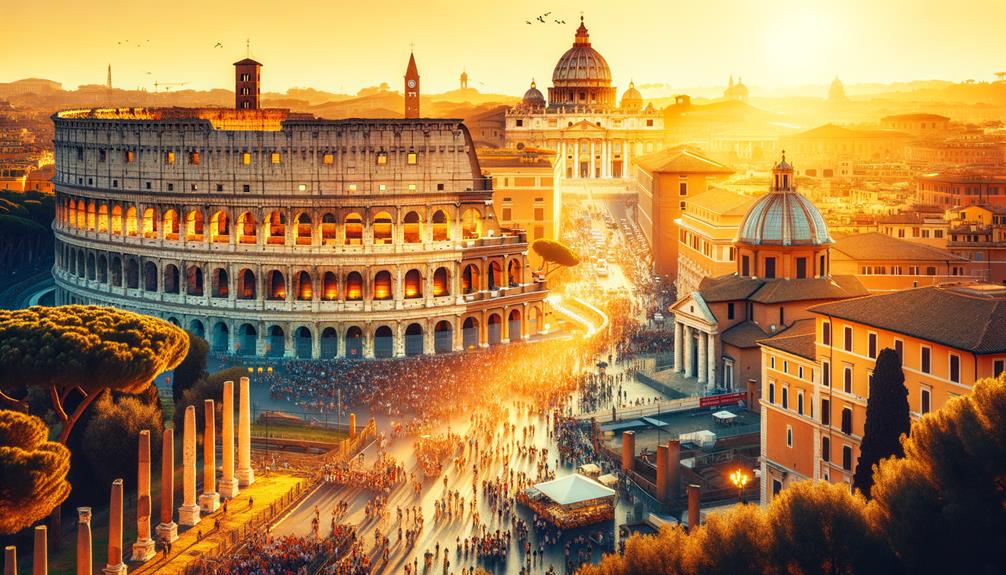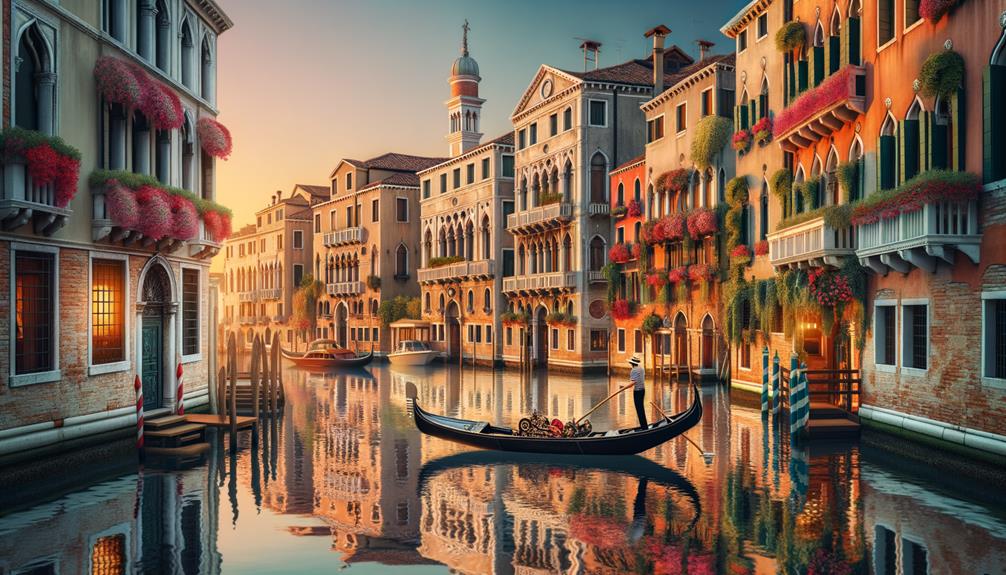Did you know that more than 4 million people visit the Colosseum every year? Standing before this ancient amphitheater, I couldn't help but think about the gladiators and the roaring crowds that once packed its seats. Wandering through the Roman Forum next door, I felt history in every stone, imagining the political dramas that took place there. While the Vatican Museums are home to some of the world's most treasured art, I found unexpected peace in the Pantheon's oculus, a perfect circle of sunlight. But Rome's charm goes beyond its famous landmarks…
Colosseum
How can anyone visit Rome without being drawn in by the grandeur and historical significance of the Colosseum, the iconic amphitheater that has stood tall since the 1st century AD? Stepping inside, I was amazed by its sheer size—imagine over 50,000 spectators cheering on gladiator battles and animal hunts. The Colosseum's elliptical shape and facade adorned with Doric, Ionic, and Corinthian columns evoke a sense of awe, blending Greek inspiration with Roman ingenuity.
Wandering through the ancient corridors, I felt the echoes of history. The complex system of pulleys, counterweights, and ramps once used to create elaborate stage sets showcased the Romans' engineering talents. It's a reminder of the empire's ingenuity and its flair for spectacle.
From the Colosseum, I gazed toward the Roman Forum and Palatine Hill, imagining the vibrancy of ancient Rome. Despite centuries of earthquakes and stone robbers, the Colosseum remains a resilient symbol of cultural heritage. It drew me in, not just as a historical monument but as a testament to the human spirit's enduring quest for greatness. Visiting it isn't just a trip through history; it's a celebration of freedom itself.
Roman Forum
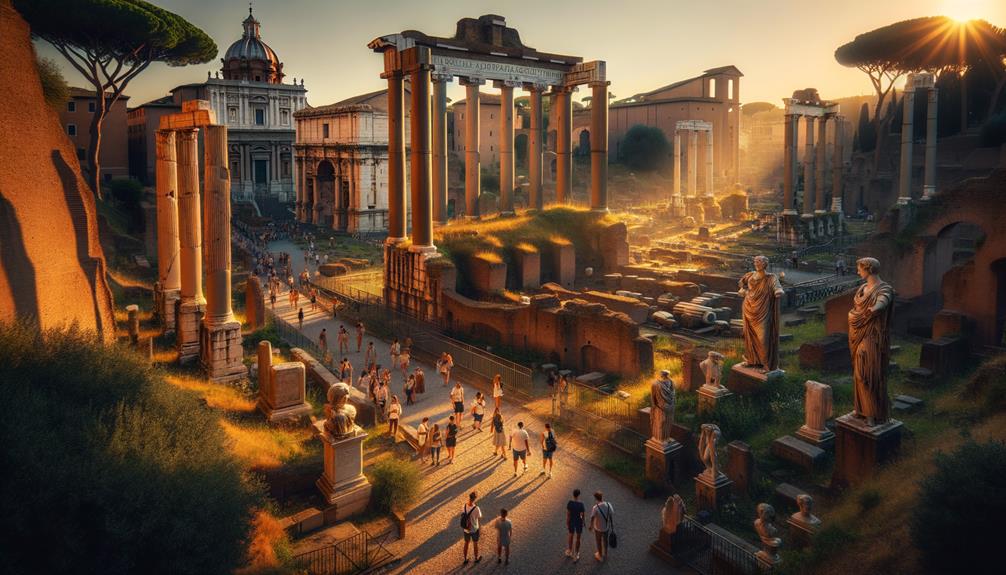
As I stepped into the Roman Forum, I felt like I had traveled back to the core of ancient Rome's political, religious, and social life. Walking among the ruins, I was amazed by the remnants of temples, basilicas, and arches that once defined Rome's landscape. The grandeur of the ancient Roman architecture made it easy to picture the bustling activity that once filled these spaces.
| Structure | Purpose |
|---|---|
| Temple of Saturn | Religious ceremonies |
| Basilica Julia | Legal proceedings and events |
| Arch of Titus | Commemorative monument |
Standing before the Temple of Saturn, I felt deeply connected to Rome's history, knowing it was dedicated to the god of wealth and time. Nearby, the Basilica Julia, once a hub for legal matters, reminded me of the complexities of Roman governance. The Arch of Titus, both solemn and celebratory, captured Rome's victories and losses.
Every step in the Roman Forum brought a sense of wonder and respect for the civilization that influenced so much of the modern world. Immersed in this ancient Roman heart, I felt as though history itself had opened its doors to me.
Vatican Museums

Walking into the Vatican Museums, I was immediately overwhelmed by the lavishness and deep history that seemed to fill every space. Each room unveiled a new layer of artistic and cultural importance, making me feel like I was stepping through a living timeline of human creativity and dedication.
One of the most breathtaking moments was standing under the ceiling of the Sistine Chapel. Michelangelo's work felt almost otherworldly, like a direct connection to the divine. The detailed biblical scenes, painted with such precision, left me in awe. I couldn't help but think about the countless hours and immense passion that went into creating it.
Moving on to St. Peter's Basilica, the grandeur continued. The immense size of the basilica, along with its stunning architecture and spiritual atmosphere, made it a place for deep reflection. The Vatican Museums as a whole, with their vast collections and stunning beauty, captured the essence of Rome's unmatched cultural heritage.
Exploring these wonders wasn't just a tour; it was an immersive experience that sparked a sense of freedom and connection to the past, present, and future.
Pantheon
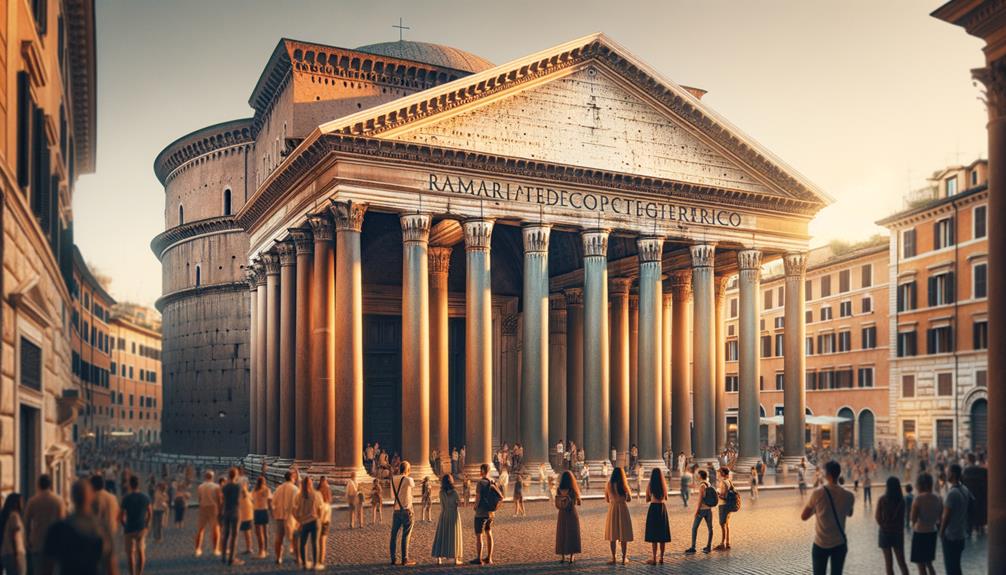
Stepping into the Pantheon, the grandeur of its ancient architecture struck me right away, especially the massive dome overhead. The oculus at the top allows a shaft of natural light to flood the interior, creating a mystical atmosphere. This nearly 2,000-year-old marvel, originally dedicated to all Roman gods and now a church, still inspires awe with its blend of history and engineering.
Architectural Marvel and History
The Pantheon, with its breathtaking dome and timeless design, stands as a testament to Rome's architectural brilliance and rich history. Walking through this ancient Roman marvel, I was struck by how it has endured through the ages. Built in 126 AD, it remains one of the best-preserved buildings from ancient Rome, and it's easy to see why. The Pantheon's design, blending elements of ancient Greek architecture with its grand temple fronted by eight Corinthian columns, is truly remarkable.
I couldn't help but admire the ingenuity of its creators. The massive dome, measuring 43.4 meters in both height and diameter, is still the world's largest unreinforced concrete dome. A few things stood out to me:
- The recessed panels, or coffers, in the dome that reduce its weight without compromising strength.
- The continuous use of the Pantheon, from a Roman temple to a Christian church and now a cultural icon.
- Its design has inspired countless other buildings, including the U.S. Capitol.
- The feeling of stepping back in time, standing where Romans once stood.
- The Pantheon's role as a symbol of Rome's enduring legacy.
Each of these aspects adds layers to the Pantheon's significance, making it a must-see for anyone with a passion for history and architecture.
Oculus and Interior Design
Standing under the Pantheon's oculus, I felt deeply connected to history as sunlight poured through the round opening, casting a soft glow on the beautifully designed interior. The beam of light moved throughout the day, almost like a spotlight from the heavens, highlighting the splendor of this ancient structure. The oculus is a remarkable architectural feature, providing both light and a symbolic link between the temple and the sky.
The Pantheon's interior is truly stunning. The coffered dome, the largest unreinforced concrete dome in the world, rises above, showcasing Roman engineering at its best. Looking around, I saw a perfect mix of geometric patterns and luxurious materials like marble and bronze, creating a space that feels both grand and intimate.
I couldn't help but think about the dome of St. Peter's Basilica. While clearly inspired by the Pantheon, it adds its unique touch to Rome's skyline. Being here, surrounded by rich history and incredible design, I felt a thrilling sense of freedom, as if the ancient and modern worlds had seamlessly blended in this timeless place.
Trevi Fountain
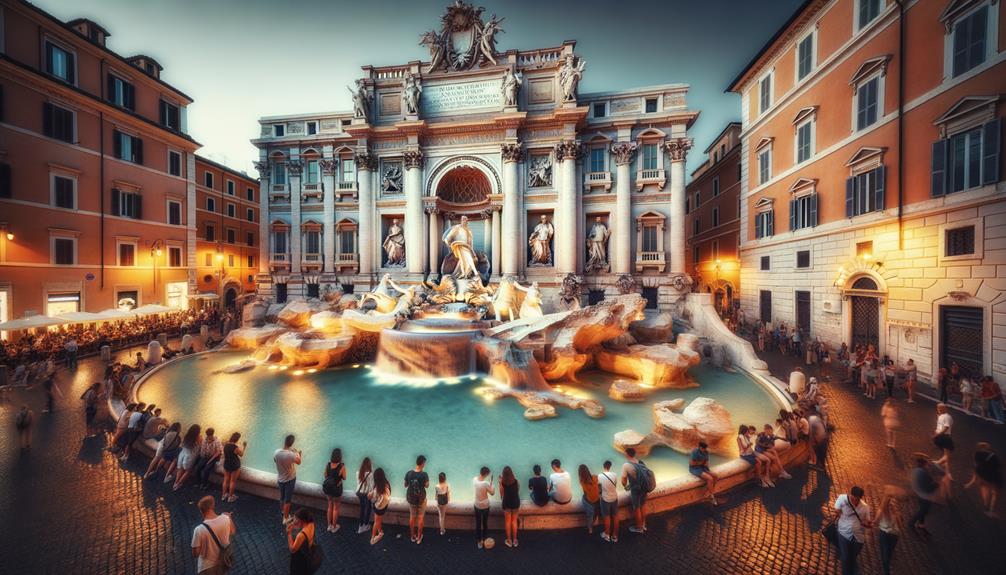
Standing in front of the stunning Trevi Fountain, I can't help but admire its intricate baroque design and rich history. Tossing a coin over my shoulder into the fountain feels like more than a tourist tradition; it connects me to centuries of stories and dreams. As the water glistens in the Roman sunlight, I feel part of a timeless cultural experience.
Historical Significance Explained
The Trevi Fountain is often celebrated as the perfect example of baroque beauty, blending Rome's rich history and artistic talent into its stunning design. Completed in 1762, this famous landmark stands as a testament to the city's lasting legacy and cultural vibrancy.
At 85 feet high and 160 feet wide, the Trevi Fountain is one of the largest baroque fountains in the world. Its impressive size commands attention at the junction of three roads, known as 'Trevi'. Commissioned by Pope Clement XII in 1732, Nicola Salvi designed the fountain to be the grand conclusion of the Aqua Virgo aqueduct, which has been supplying water to Rome since ancient times.
Architectural Highlights: The central arch, surrounded by mythological figures, features Neptune, the god of the sea, in a magnificent chariot.
Historical Importance: The fountain marks the end point of the Aqua Virgo aqueduct, linking Rome's past with its present.
Pop Culture Impact: Its appearances in films like 'La Dolce Vita' have boosted its global fame.
Symbolic Details: Each statue and carving tells a story, showcasing Rome's deep-rooted traditions.
Civic Pride: The fountain represents the city's dedication to integrating art into daily life.
Every visit to the Trevi Fountain is a journey through history, art, and culture seamlessly entwined.
Coin Toss Tradition
Tossing a coin into the Trevi Fountain isn't just a playful act; it's a beloved tradition that promises a return to Rome for those who take part. As I stood before the Fontana di Trevi, I felt a connection to the countless people who've made the same wish over centuries. The energy around the fountain is tangible, with tourists eagerly turning their backs to the water, coin in hand, ready to join in this age-old ritual.
The coin toss isn't just about ensuring a future trip to Rome; it's a moment of magic that ties you to the city's rich history. Each coin represents a hope, a dream, or perhaps a silent promise to oneself. As I tossed my coin over my shoulder, I felt a bond with this magnificent city, a place where ancient history meets the present.
The sparkling waters of the Fontana di Trevi seem to whisper secrets of the past and future. Watching the coins glint in the sunlight, I realized that this simple act is more than just a wish—it's a declaration of Rome's enduring allure, a promise that I'll be back.
Spanish Steps

Situated in the heart of Rome, the Spanish Steps gracefully rise from the lively Piazza di Spagna, blending architectural beauty with cultural significance. Standing at the base, I was struck by how the 138 steps, designed by Francesco de Sanctis in 1725, create an elegant path to the Trinità dei Monti church. Funded by French diplomat Étienne Gueffier, the steps are named after the nearby Spanish Embassy to the Holy See.
The Spanish Steps are more than just a staircase; they're a lively gathering spot. I saw people from all walks of life stopping to take in the scene, reflecting on the rich history around them. The area draws those seeking freedom and inspiration.
- Architectural brilliance: The steps highlight de Sanctis' skill, fitting perfectly into the city's fabric.
- Cultural hotspot: A prime location for people-watching and unwinding.
- Film history: Iconic scenes from movies like 'Roman Holiday' were filmed here.
- Shopping delight: Upscale boutiques and restaurants surround the steps.
- Stunning views: The top provides panoramic views of Rome and the historic Trinità dei Monti church.
The Spanish Steps capture Rome's timeless charm, inviting us to wander and dream.
Capitoline Museums
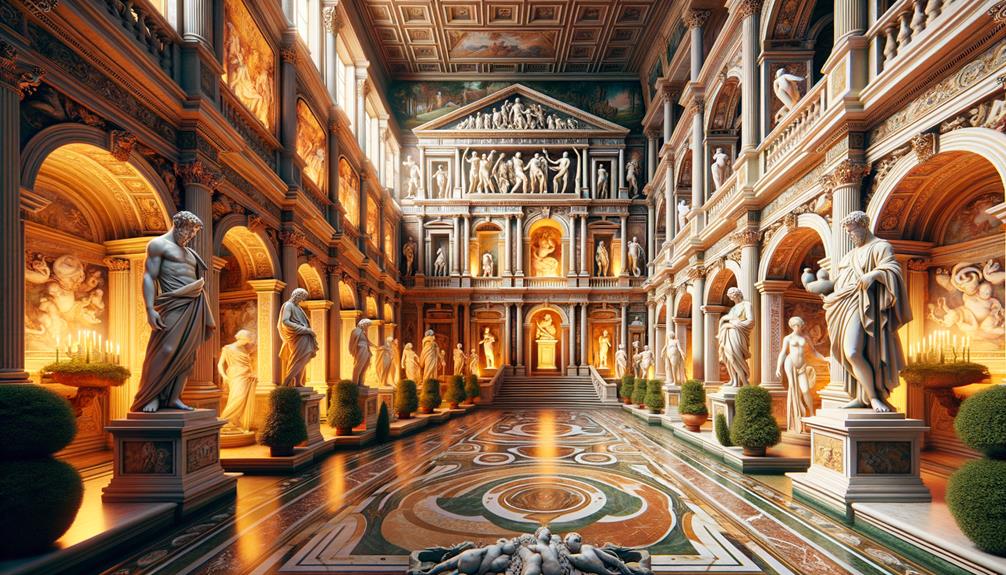
Strolling through the Capitoline Museums, I felt like I was stepping into a vault of ancient and Renaissance masterpieces. The beauty of the ancient sculptures, like the iconic she-wolf with Romulus and Remus, left me speechless. The historical artifacts and stunning Renaissance artworks on display added layers of depth to my understanding of Rome's rich cultural history.
Ancient Sculpture Collection
The Capitoline Museums in Piazza del Campidoglio house an impressive collection of ancient Roman sculptures, offering a deep insight into Rome's artistic and cultural heritage. Walking through the halls of the Palazzo dei Conservatori, I found myself captivated by the remarkable pieces around me. These sculptures are more than just historical artifacts; they tell stories of Rome's magnificence and rich history.
Standing before the She-Wolf, nursing Romulus and Remus, I felt a strong connection to Rome's founding myth. The equestrian statue of Marcus Aurelius radiates power and elegance, while the massive head of Constantine commands attention with its sheer size and presence. The Capitoline Venus, with her delicate beauty, provides a more personal glimpse into ancient Roman art.
- She-Wolf nursing Romulus and Remus: Symbolizes Rome's origin.
- Equestrian statue of Marcus Aurelius: Represents imperial power.
- Colossal head of Constantine: Imposing and awe-inspiring.
- Capitoline Venus: Embodies Roman beauty.
- Palazzo dei Conservatori courtyard: A peaceful area rich in history.
Every piece in the Capitoline Museums, spread across the Palazzo dei Conservatori and Palazzo Nuovo, invites visitors to step back in time and experience Rome's lasting legacy.
Renaissance Artworks Display
The Capitoline Museums' Renaissance artworks display, showcasing pieces by Titian, Tintoretto, and Caravaggio, offers an incredible glimpse into one of the most important periods in art history. As I walked through the Palazzo dei Conservatori and Palazzo Nuovo, connected by an underground tunnel, I felt deeply connected to the artistic changes that defined the Renaissance.
Titian's brushstrokes seemed to share stories of vibrant Venetian life, while Tintoretto's dramatic compositions drew me into their intense scenes. But it was Caravaggio's use of chiaroscuro, the striking contrast of light and shadow, that truly grabbed my attention. His works made me feel as though I was entering a world where every detail was carefully designed to evoke emotion and thought.
Beyond the paintings, the Capitoline Museums' Renaissance collection also includes beautiful decorative arts. The intricate tapestries and ornate furniture transported me to luxurious palaces, while delicate ceramics showcased the refined tastes of the era. Each piece told a story, not just of art but of the cultural and social changes that marked the Renaissance.
Exploring these masterpieces, I couldn't help but admire the freedom and creativity that thrived during this transformative period, a spirit that still resonates in Rome today.
Historical Artifacts Exhibition
Walking into the Capitoline Museums' Historical Artifacts Exhibition, I was struck by the vivid display of Rome's ancient history. These artifacts weren't just old objects; they were storytellers, echoing the tales of a once-powerful empire. From the detailed mosaics to the timeworn statues, each piece seemed to carry the weight of history.
I found myself comparing these treasures to others I've seen around Rome, like those in Palazzo Massimo. Still, the Capitoline collection had its own special appeal, mixing grandeur with a sense of personal discovery. Among the highlights, I saw:
- Ancient Roman busts, capturing the stern faces of emperors and philosophers
- Bronze figures that looked ready to come to life
- Marble sarcophagi intricately carved with mythological scenes
- Coins and jewelry showing glimpses of everyday Roman life
- Architectural fragments hinting at the glory of long-lost buildings
Thinking back to my visits to Villa Borghese and the Doria Pamphilj Gallery, I noticed how each museum in Rome offers a unique perspective on the city's layered history. The artifacts at the Capitoline Museums made me feel connected to an ancient world, a testament to humanity's enduring spirit of curiosity and creativity.
Piazza Navona
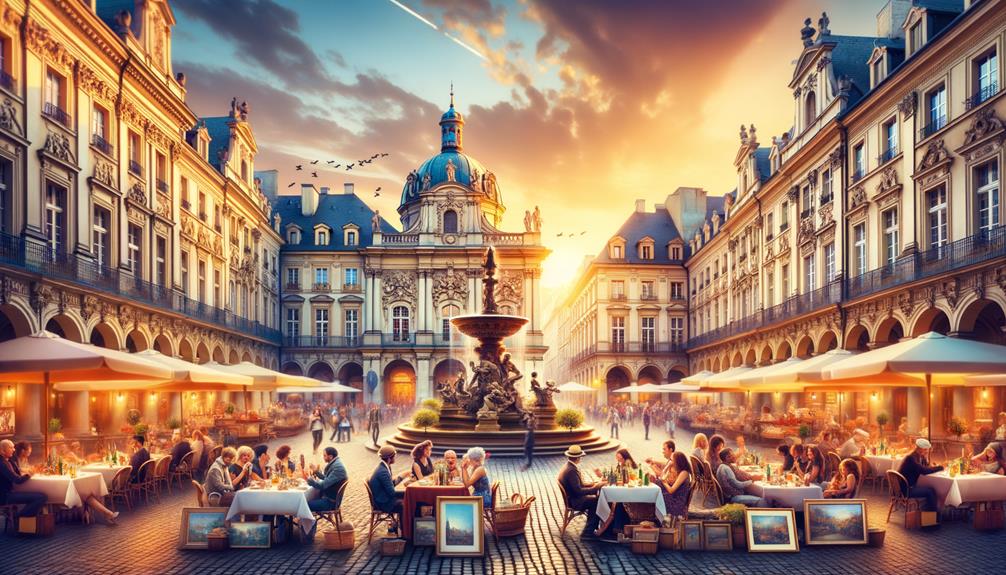
When I step into Piazza Navona, I'm immediately taken by its lively vibe. The stunning Baroque architecture and the enchanting Fountain of the Four Rivers set a beautiful scene. Located in the heart of Rome, this square is one of the city's most charming places. The melodies of street musicians, the scent of fresh espresso, and the buzz of art vendors create a sensory feast.
As I get closer to the Fountain of the Four Rivers, I can't help but admire the detailed sculptures that depict the four great rivers known in the 17th century: the Nile, Ganges, Danube, and Rio de la Plata. The craftsmanship is extraordinary, with each river god having a distinct personality.
| Observation | Personal Reflection |
|---|---|
| Baroque Architecture | The intricate designs draw me in. |
| Fountain of Four Rivers | It's a stunning work of art. |
| Street Performers | Their skill adds a magical touch. |
Around the piazza, elegant buildings like the Church of Sant'Agnese in Agone highlight Rome's architectural splendor. The church's facade is a perfect example of Baroque elegance, inviting me to explore its peaceful interior. Sitting at a nearby café, sipping my cappuccino, I feel deeply connected to the layers of history and culture that have shaped this remarkable square.
Villa Borghese

When you step into Villa Borghese, the lush gardens immediately pull you in, offering a peaceful retreat from Rome's busy streets. This large green space feels like an oasis, a perfect break from the city's fast pace. As I stroll through the well-kept lawns and shaded paths, I can't help but think about how beautifully nature and art come together in this park.
The area around Villa Borghese has a lively but laid-back vibe, with cozy cafes and hidden spots that are worth checking out. From the hilltops, especially the Pincio Terrace overlooking Piazza del Popolo, you get some of the best views of Rome.
Galleria Borghese: Houses works by Bernini, Caravaggio, and Raphael.
Bioparco di Roma: A charming zoo that's great for families.
Pincio Hill: Offers stunning city views.
Lake Garden: Rent a rowboat and float among classical statues.
Silvano Toti Globe Theatre: Enjoy a Shakespeare play in this replica of the Globe Theatre.
Villa Borghese is more than just a park; it's a place where art, history, and nature meet, providing a deep sense of freedom and peace. The park's calm atmosphere is a welcome break from the city's hustle, giving you a chance to relax and recharge.
St. Peter's Basilica

St. Peter's Basilica is an incredible example of Renaissance architecture and holds a special place as the spiritual center of the Catholic Church. Walking through St. Peter's Square, I was struck by a profound sense of awe. The grand facade, crafted by masters like Michelangelo and Bernini, demands both attention and respect.
Inside, the vast nave is simply stunning. The detailed mosaics, the towering Baldacchino, and Michelangelo's Pietà are all works that invite deep reflection. Every corner tells a story of devotion and artistic talent. Standing beneath the dome, I felt both small and inspired, gazing up at Michelangelo's masterpiece.
Exploring beneath the Basilica, I found the Vatican Grottoes. Here, the tombs of past Popes rest quietly, offering a stark contrast to the splendor above. The history of St. Peter's is tangible, a reminder of the centuries of faith and influence that have shaped this place.
Stepping out onto the roof, the panoramic view of Rome is a thrilling reward. The city stretches out, ancient yet vibrant, a testament to time and human effort. St. Peter's Basilica isn't just a building; it's a journey through history, art, and spirituality.
Frequently Asked Questions
What Shouldn't You Miss in Rome?
When you're in Rome, don't miss the Colosseum's impressive structure, the Vatican's stunning art, the echoes of history at the Roman Forum, the architectural beauty of the Pantheon, and the charm of the Trevi Fountain. Each of these sites gives you a taste of what makes Rome so unforgettable.
What Is the Number One Must See in Rome?
The top attraction you absolutely have to see in Rome is the Colosseum.
I was in awe of its massive size and detailed architecture. Walking through its ancient tunnels, I felt a strong connection to history and the many stories hidden within its walls.
Is 3 Days Enough for Rome?
Is three days really enough to get the full feel of Rome? It's a city that had me absolutely charmed with its lively streets and deep history, but there's always something new to see. Enjoy every second, make the most of your time, and plan to come back.
How Many Days Do I Need in Rome to See Everything?
Seeing all of Rome takes about 7-10 days. The city's deep history and diverse neighborhoods are worth the time. However, if you're short on time, 3-5 days can still let you enjoy the main attractions.

